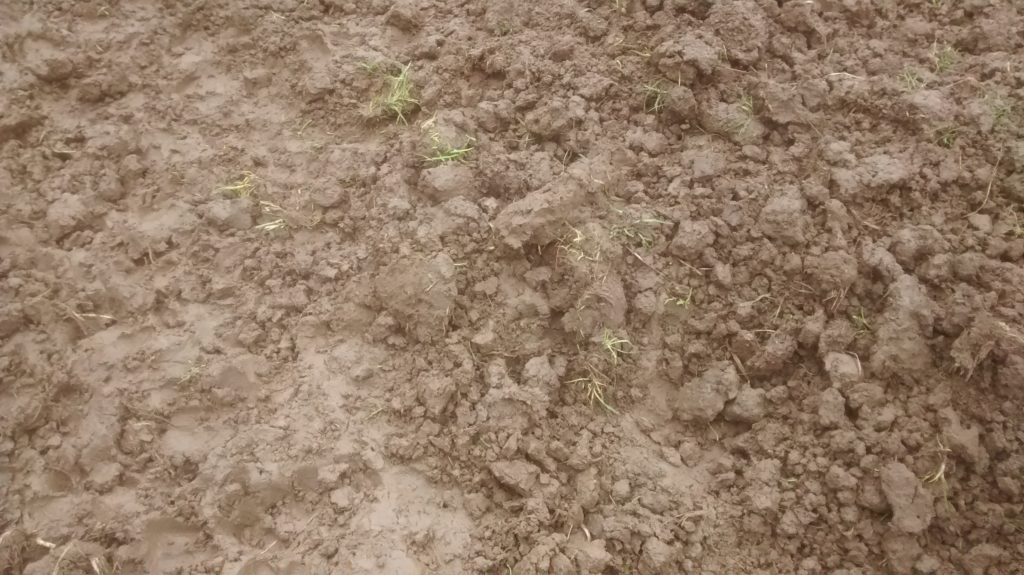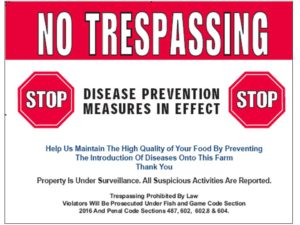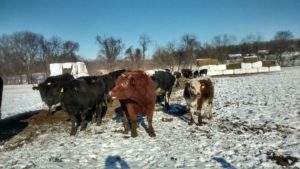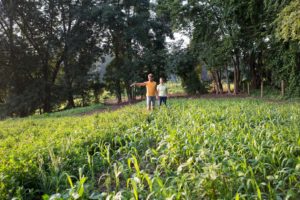 Our neighbor startled me last week, when I looked up from watering the pigs, and there he was. He had walked quietly, carefully across the field, not wanting to scare the animals. He saw me out working, and wanted to discus some neighborly topic, which we did. As the conversation continued, he asked why we weren’t rotating the cattle? Our cows have stayed at one place since the new year, and with the recent warm temperatures and plenty of rain, that area, frankly, looks terrible. Quite the contrast from the growing season (growing season = spring, summer, fall) when our herd moved relatively quickly across the land, happily munching their way through knee-high grasses and alfalfa.
Our neighbor startled me last week, when I looked up from watering the pigs, and there he was. He had walked quietly, carefully across the field, not wanting to scare the animals. He saw me out working, and wanted to discus some neighborly topic, which we did. As the conversation continued, he asked why we weren’t rotating the cattle? Our cows have stayed at one place since the new year, and with the recent warm temperatures and plenty of rain, that area, frankly, looks terrible. Quite the contrast from the growing season (growing season = spring, summer, fall) when our herd moved relatively quickly across the land, happily munching their way through knee-high grasses and alfalfa.
But now here in February we have a muddy brown lot, and on the other side of the fence was semi-grassy, albeit, mostly dead grass. Wouldn’t it be better for the cows to rotate to there?
It’s a good question, and I’m glad he asked it. We should ask questions about animals that will become our food; What are they eating? Is it healthy? Are the animals healthy? Why or why not? How often are animals getting sick?
We should ask questions about the land, and the animal and farmer impact on the land; Is the farmer building soil or destroying it? How does this farm impact bio-diversity? (There are numerous more questions that could be asked: How are workers treated? Are the owners earning a living wage? How are the farmers preparing for the future? You get the picture.)
 We want people to ask questions. Questions are an indication of an observant person. The conventional food system is full of the ‘don’t come in, don’t ask, and don’t tell’ mentality. If your farmer ever makes you feel stupid because of your questions, then look for another farmer. It’s important to have that relationship with your farmer…they’re growing or raising food that you’re going to put into your body and feed your children. Questions are important. Anyway, I could go on about a food system that’s trying to tell us what’s good for us, and belittles the dissenters or a questioning person. But, moving on to the wintertime questions and concerns…
We want people to ask questions. Questions are an indication of an observant person. The conventional food system is full of the ‘don’t come in, don’t ask, and don’t tell’ mentality. If your farmer ever makes you feel stupid because of your questions, then look for another farmer. It’s important to have that relationship with your farmer…they’re growing or raising food that you’re going to put into your body and feed your children. Questions are important. Anyway, I could go on about a food system that’s trying to tell us what’s good for us, and belittles the dissenters or a questioning person. But, moving on to the wintertime questions and concerns…
What’s up with the mud? And why aren’t we rotating our cattle?
So let’s talk about Winter Management.
First, I’ll tell you our plan, what we were thinking in August / September (yes, we need to think about winter early). Then I’ll discus what we wish we would’ve done differently, and mention things that are actually going well. Lastly, I’ll talk about long term, and how we hope to improve things in the next 5-10 years. We always need to be looking to the future, even as we work at the immediate tasks.
Our plan: There’s a field (F-6A) we want to renovate and re-seed. We want to plant some annuals (grains, but maybe some pumpkins and corn or sorgum sudan grass) and experiment with grazing that, before new pasture is established. So we’ll winter the cows in Field 6A, starting them on the east end (road end), and periodically move the west fence further west. Where they eat, is also where they poop alot. We feed hay under the west fence, so moving the fence will give them a clean place to eat, and will also spread the manure around. When animals stay in one place, they tear it up, and their manure is concentrated there. We’ll use that to our advantage, since we want to tear it up and re-seed in the spring anyway, and the manure will be utilized as fertilizer to grow whatever we plant.
What we wish we would’ve done differently: We wish we would’ve started at the west end with the cattle, and have moved east with the front fence/feeding fence. That way we would’ve been driving over undisturbed ground every time Tyler brings out another load of hay. He watches the weather, looking for a hard freeze (which are harder to come by, it seems) to use the equipment. Last week though, the cows ran out of hay, and it was muddy, with no freeze in the forecast. The tractor almost got stuck, and we had to feed along the road. Not ideal.
Starting at the west end, away from the road, also means this un-sightly lot would be further from public view. Not that we’re trying to hide anything (we can’t really, along Rt. 441) but when people drive by, we don’t want them to think, ‘ug…that’s an ugly farm’.
 What’s going well: Our cattle. Our cattle are looking great. They’re well fed and healthy, and it shows. Even the calves. They have access to minerals, which keeps their immune systems in excellent condition. Their coats are full, and they’ve acclimated to winter weather. They don’t actually need shelter. In fact, dank, dark and drafty barns are more likely to make them sick due to stale air.
What’s going well: Our cattle. Our cattle are looking great. They’re well fed and healthy, and it shows. Even the calves. They have access to minerals, which keeps their immune systems in excellent condition. Their coats are full, and they’ve acclimated to winter weather. They don’t actually need shelter. In fact, dank, dark and drafty barns are more likely to make them sick due to stale air.
Long Term: This land was an alfalfa field before we started managing it last spring. Alfalfa is great…it’s roots grow long, able to mine minerals from deep in the earth. But alfalfa needs to be coupled with other plants for a holistic pasture. Other plants, like grass. Grass grows from ‘root balls’, creating clumps. Thick, clumpy grass creates a structured sod layer, which acts as springs on top of the soil. It helps to protect the soil below, minimizing compaction when an 800lb animal walks on it, even when it’s wet.
We want to build/grow diversity into our pastures and farmsystem. Diversity is beautiful, necessary, and adds strength. As we graze, re-seed, over-seed, and rejuvenate the  land this coming growing season, we will have an eye towards the future, and future winters. As our pastures become stronger and more resilient, we’ll be able to rotationally graze longer into the winter, and begin earlier in the spring. I don’t know, but perhaps, sometime, our land will be diversified enough, with so much biomass, to rotationally graze year round. But we expect that next winter we will likely have another mud lot. It won’t be at the same place, but sometime in late summer we’ll pick a spot, maybe another spot that needs renovated, and let it grow long before the animals winter there. This lets the rest of the pastures hibernate peacefully, waiting for Spring to bring it alive.
land this coming growing season, we will have an eye towards the future, and future winters. As our pastures become stronger and more resilient, we’ll be able to rotationally graze longer into the winter, and begin earlier in the spring. I don’t know, but perhaps, sometime, our land will be diversified enough, with so much biomass, to rotationally graze year round. But we expect that next winter we will likely have another mud lot. It won’t be at the same place, but sometime in late summer we’ll pick a spot, maybe another spot that needs renovated, and let it grow long before the animals winter there. This lets the rest of the pastures hibernate peacefully, waiting for Spring to bring it alive.